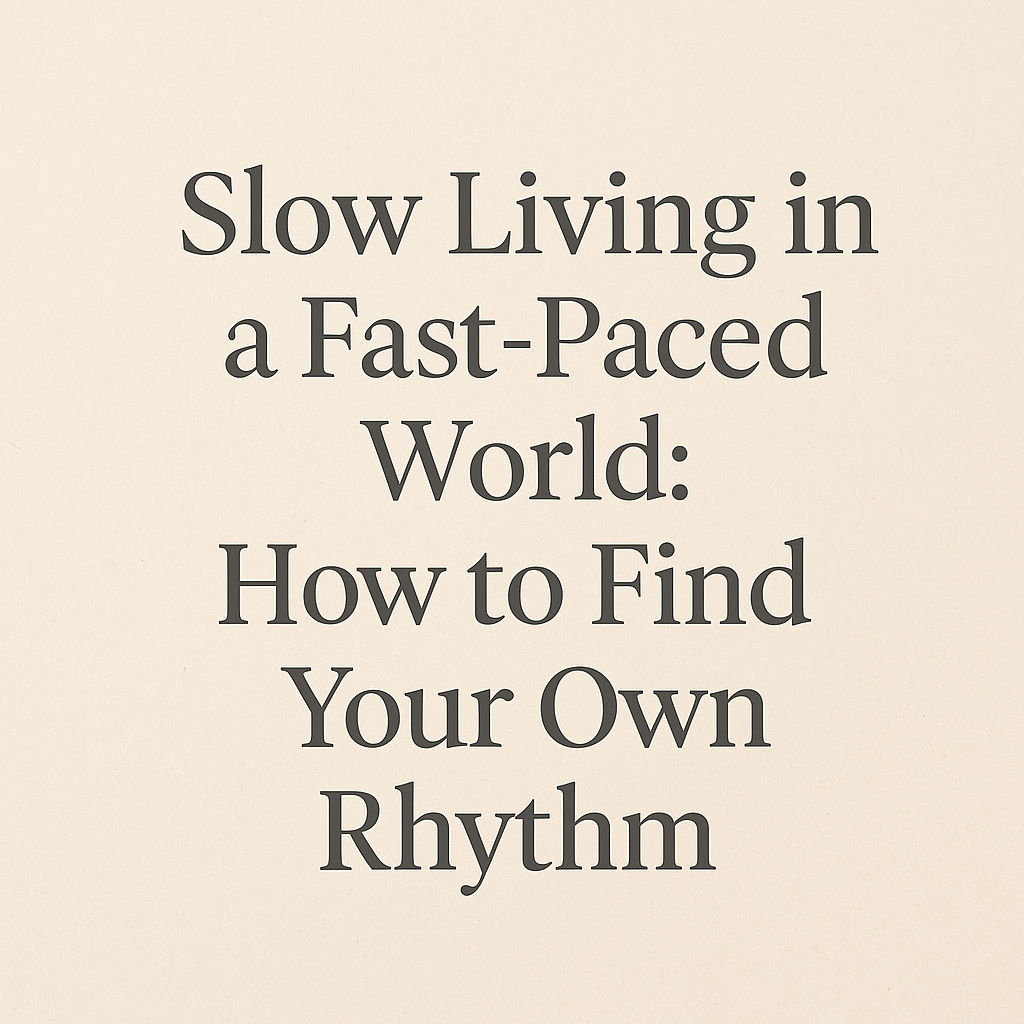Introduction
Slow Living in a Fast-Paced World: How to Find Your Own Rhythm. In a world where speed is glorified and busyness is worn as a badge of honor, slowing down can feel almost rebellious. The modern lifestyle constantly demands more—more productivity, more efficiency, and more accomplishments. But amidst the hustle, many are finding solace in a different approach: slow living.
Slow living is not about laziness or inefficiency; it’s about being intentional with your time and energy, savoring the present moment, and creating a life aligned with your values. In this blog, we’ll explore the philosophy of slow living, its benefits, and practical ways to incorporate it into your daily life.
Table of Contents
The Philosophy Behind Slow Living
Slow living is rooted in mindfulness and intentionality. It encourages individuals to step away from the relentless pursuit of ‘more’ and instead focus on ‘better.’ This concept has historical roots in movements like the Slow Food Movement, which began in Italy as a response to the rise of fast food culture. Over time, this philosophy has extended beyond food to include work, relationships, and daily routines.
At its core, slow living is about quality over quantity, depth over breadth, and presence over distraction. It’s about curating a life that feels fulfilling rather than just busy.
Why Is Slow Living Important in 2025?
The world is more connected and fast-paced than ever. Social media, instant messaging, and demanding work schedules have blurred the lines between personal and professional life. The pressure to always be ‘on’ has led to rising cases of burnout, anxiety, and a general feeling of being overwhelmed.
Studies show that chronic stress and overwork can lead to severe health issues, including heart disease and mental exhaustion. Slow living offers an antidote to this chaos by promoting balance, well-being, and deeper connections.
Related Link: The Science Behind Burnout and How to Prevent It
The Benefits of Embracing Slow Living
1. Improved Mental Health
When you slow down, your mind has the space to breathe. You become more aware of your thoughts, emotions, and overall mental state. This reduces anxiety and promotes a sense of inner peace.
2. Stronger Relationships
Slow living encourages meaningful conversations and genuine connections. Instead of being distracted by notifications, you can be fully present with loved ones, strengthening your relationships.
3. Enhanced Productivity
Ironically, slowing down can make you more productive. When you focus on one task at a time instead of juggling multiple things, you produce higher-quality work in less time.
4. Better Physical Health
A slow and mindful approach to eating, exercising, and resting improves overall health. You become more in tune with your body’s needs, reducing stress and improving well-being.
5. Greater Appreciation for Life
When you’re not rushing through your days, you start noticing the beauty in small things—morning sunlight, the aroma of coffee, a heartfelt conversation. This heightened awareness leads to a richer, more fulfilling life.
How to Incorporate Slow Living into Your Daily Life
1. Start Your Day Mindfully
Avoid jumping straight into emails or social media upon waking up. Instead, begin your day with a slow ritual—stretching, deep breathing, or enjoying a cup of tea without distractions.
2. Prioritize What Truly Matters
Ask yourself: What are the most important things in my life? Instead of filling your schedule with unnecessary commitments, focus on what brings joy and purpose.
3. Practice Digital Detox
Technology is a double-edged sword. Set boundaries by turning off notifications, scheduling screen-free hours, and engaging in offline activities like reading, walking, or journaling.
4. Embrace Slow Food
Cook meals from scratch, savor each bite, and enjoy mealtime as a moment of relaxation rather than a rushed necessity.
5. Adopt a Slower Work Ethic
Instead of multitasking, focus on deep work. Take breaks, set realistic goals, and create a work-life balance that nurtures creativity and well-being.
6. Spend Time in Nature
Being in nature naturally slows you down. Whether it’s a morning walk, a weekend hike, or simply sitting in a park, connecting with nature brings a sense of calm and clarity.
7. Say ‘No’ More Often
One of the biggest challenges in modern life is overcommitment. Learn to say no to things that don’t align with your priorities. This will free up time for activities that truly matter.
8. Cultivate Gratitude
A gratitude practice shifts your focus from what’s missing to what’s abundant in your life. Take a few moments each day to reflect on what you’re grateful for.
Real-Life Examples of Slow Living
- Marie Kondo’s Approach to Minimalism – Emphasizing joy and simplicity in material possessions.
- Carl Honoré’s Slow Movement Advocacy – Promoting the importance of slowing down in various aspects of life.
- Scandinavian Hygge Lifestyle – The Danish philosophy of coziness and enjoying simple pleasures.
Related Link: The Hygge Manifesto: How to Bring Coziness into Your Life
Overcoming Challenges in Slow Living
- FOMO (Fear of Missing Out): Remind yourself that you’re gaining more depth and quality in life rather than mindless quantity.
- Work Pressures: Advocate for healthier work environments and set personal boundaries.
- Social Expectations: Communicate your lifestyle choices to friends and family, encouraging them to embrace a similar mindset.
Final Thoughts
Slow living is not about rejecting modern life but about approaching it more consciously. It’s about finding your own rhythm amidst the noise and chaos, creating a life that feels intentional and fulfilling.
As you embark on this journey, remember: the goal is not to live a ‘perfect’ slow life but to make small, meaningful shifts that bring joy, clarity, and peace.
Are you ready to slow down and reclaim your time? Let’s start today.
Related Link: The Psychology of Mindful Living
Find more Lifestyle & Personal Development content at: https://allinsightlab.com/category/lifestyle-personal-development/

